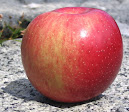
|
John Chapman, popularly called Johnny Appleseed, is responsible in large part for the genetic diversity of American apples.
He was also born not far from where I live, and his birthday was last month (which is when I tasted this apple).
So it seems entirely appropriate that someone should name an apple for him. Similarly, that they should be ripe on his birthday, ready for me to taste and tell you about.
Johnny Appleseed the apple is medium to large (not huge, just large) and oblate. Ribbing is basically invisible, but if you run a finger around the base you can feel bumps.
He's got a red blush showing some darker streaks over yellow-green peel, in which lighter lenticels can be hard to spot.
The skin has a matte rather than glossy finish, and both my samples have splashes of coppery russet radiating from the stem well.
This has a fine traditional appearance, yet the name suggests a modern variety. Let's see.
Taste the apple
It is quite sweet, but there are also tart and bitter notes, the latter possibly from the peel.
The net effect is light and interesting, though for me it seemed to lack some punch or emphasis. The apple did, however, leave a pleasant finish behind in my mouth.
Johnny started to brown before I finished eating.
Pedigree
Raintree Nursery, in Washington, sells these trees (or one with the same name and general appearance).
Raintree says theirs is a graft from a particular tree planted by John Chapman in Ohio, which was the frontier in Chapman's day.
(Ironically, Chapman was not about grafted cultivars. Quite the opposite!)
Wikipedia has a similar story about this apple (towards the end of its extensive entry on Johnny Appleseed), identifying the location of the tree. But many of the assertions are unsourced.
I am reminded of the record on Flower of Kent, which almost identifies that apple as the one that, falling, inspired Newton.
Of course there could be more than one tree attributed to Chapman, and more than one apple by that name.
I've described this one. The story fits the qualities of this apple reasonably well.
Update: Raintree has the science to prove its link to the tree.

I Love applesauce did he create it or…
ReplyDeleteJohn was more of a cider guy.
DeleteJames from Raintree Nursery here. We actually just had a full DNA profile done of our Jonny Appleseed tree, and confirmed that it is in fact the same DNA that came from John Chapman's tree. So people can sleep easy knowing it is the right one!
ReplyDeleteJames, thank you! I am flattered that you came by. This apple really is a piece of living history.
Delete